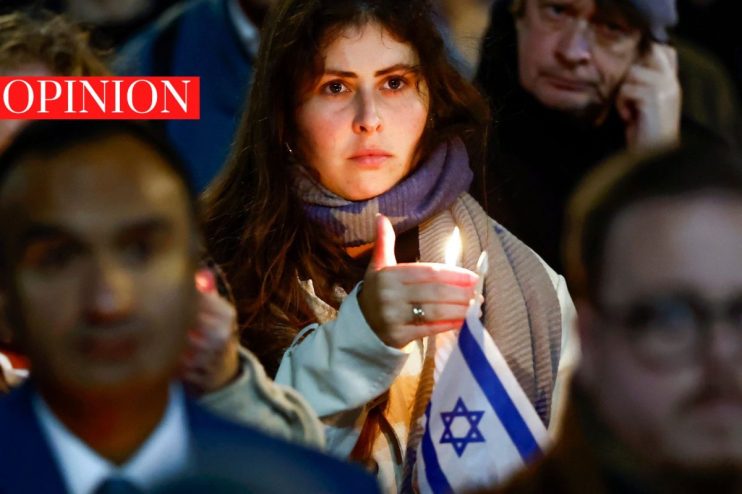Israel’s crisis is playing out live on our smartphones; we must not turn away

In times of crisis – especially the war unfolding in Israel – it is easy to denigrate social media as a conduit for horrific scenes, but it is our responsibility to face the reality, writes Eliot Wilson
The girl with the brown hair is 10 years old. She sits on her mother’s lap and seems calm as she tells the story, her voice conversational, the gutturals of her Hebrew characteristic. Behind her, the mother’s face is drawn and anxious, shock still visible.
“They shot my Dad, I couldn’t see what happened to Stav. It happened in front of my eyes. Dad managed to get one of the terrorists, but they still killed him and his partner.”
Daria is telling a reporter about the moment on Sunday morning, a week ago, when Hamas terrorists stormed Kibbutz Re’im and murdered her father, Dvir Karp, and his partner Stav. Daria’s mother, Reut, had received WhatsApp messages from Dvir about hearing gunfire in the kibbutz. Then, at 8.24 am, she received another message from the same phone: “Mom It’s Daria, Dad has been murdered.” A minute later: “Stav too.” Then, simply, “Help”.
The interview with Daria Karp was posted on X (formerly Twitter) by the government of Israel, and it joins a whole ocean of content, some violent, graphically so, most of it beyond distressing. This has raised questions about how much, if anything, should be seen and allowed to be posted, and what level of moderation or censorship should be exercised.
What began on Saturday 7 October was a pogrom. But it was a pogrom played out in front of smartphones and social media accounts, and now we are in a situation we have never faced in this way. This was not an individual shooting, a crime perpetrated by a lone criminal, nor was it a single, terrible catastrophe leading to widespread loss of life. This was a sustained massacre, carried out face-to-face by armed men from the Palestinian terrorist group Hamas, seeking out victims to kill, seeking them out because they were Jews.
The format, unfortunately, is almost as old as the Jewish people themselves. It has happened across the world and down the ages. But there was something chillingly immediate about the footage of last weekend’s barbarity. Some brave souls, taking their chances against Godwin’s Law, drew an eerily accurate comparison: the roaming bands of young Palestinian men, bloodlust burning in them, exultant, manic, pitiless, were like the Einsatzgruppen, the squads of SS paramilitaries which sought and murdered Jews and others in eastern Europe during the Second World War. Their most infamous atrocity was the slaughter of nearly 34,000 Jews at Babi Yar near Kyiv in September 1941.
Hamas’s activities have been Babi Yar with a camera phone. Tackling these millions of images is a fiendish task. A law professor from Stanford, Evelyn Douek, said “There are no good options for a platform trying to do responsible content moderation in the middle of an escalating conflict and humanitarian atrocities”. She is probably right, but I want to propose a general principle that may divide people.
If the images are genuine, let them stay up.
Parents can keep their children away from social media, and those who choose to look away have that option. But as a culture, as a society, we cannot hide these images because they upset us. They do, and they should, because they are the closest most of us will get to seeing what happened.
In this country, Ofcom, the media regulator, has been working at fever pitch. There is increasing anger at the BBC’s long-running practise of rejecting the word “terrorist”, which it argues is biased when referring to a group like Hamas. But Hamas is committed by its very foundational document to the destruction of the state of Israel, and it is a proscribed terrorist organisation in UK law. As a force which swept in to kill—as things currently stand—at least 1,200 people last weekend, by gun and knife and bomb, “terrorism” seems a mild epithet to use. It could hardly be deemed prejudicial.
I have always felt uncomfortable about turning my face away from some element of reality because it is violent or upsetting. In general I think it does us some moral good to stare the worst that humanity is capable of right back in the face, and flush out any misconceptions or self-deceptions about life. In the case of the Hamas massacres, however, it becomes not just beneficial but essential for us to be grown-up and understand that this brutality is real, and is part of the context of what happened last weekend.
Everyone has the ultimate censorship of the off switch. But I urge people not to use it. We cannot fool ourselves, and we must absorb the horrific nature of the deadliest outbreak of anti-Semitic violence since the end of the Second World War. It may be a brief gathering of thoughts, and the images we see may haunt us. But if Daria, at 10, can tell her story plainly and calmly, how little, but necessary, a sacrifice is it for us to watch and listen?